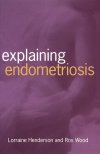A potted history of the Endometriosis Association Victoria
by Ros Wood, Australia
As the Endometriosis Association Victoria approaches its 21st birthday in 2005, I thought it might be worthwhile reflecting on our ‘life’ to date. In doing so, I have not tried to write a complete history. Rather, I have tried to give you a few insights into our main achievements and their impact.
Therefore, there are many gaps in the story, and the story does not acknowledge many of the people who have made major contributions to the Association over the years.
Inception

Ros Wood, co-founder of the Endometriosis Association Victoria
In mid 1983, I joined the Women’s Health Resource Collective, which had just received funding to set up a women’s health information service and produce leaflets on various women’s health issues.
I had been diagnosed with endometriosis a year earlier. At the time, there was no lay information on the topic. I had been able to obtain information, because I had a good understanding of medical concepts and language through my physiotherapy course, and access to Melbourne University’s medical library.
However, one of my friends who had been tentatively diagnosed with the condition soon afterwards was not so lucky. She had no medical background, so the information in the medical textbooks was gobbledegook to her. As a result, she had been dependent on me to explain the condition to her.
At one of my first WHRC meetings, we discussed topics for possible leaflets. I timidly suggested that we do one on endometriosis, because my reading had indicated that it was a common condition, and my experience had shown me there was no lay information on it.
The Collective agreed. Di Surgey, one of the WHRC staff, and I then spent six months researching and writing the leaflet. When it was published at the end of the year, the Collective asked me if I would start a self help group. I agreed, thinking ‘Yeh, we’ll get six or seven women and we’ll sit round and have a few whinges, and then it will all fold up’. How wrong I was!
The need for the group became abundantly clear in January 1984 when extracts from the leaflet were published in the women’s pages of The Age. Over the next six weeks, more than 200 women rang the WHRC to obtain the leaflet and talk about their endometriosis. The staff collected the names of all the women who wanted to join a self help group, and I organised three initial meetings for February and March.
Meanwhile, Lorraine Henderson was nearing the end of two years in England with her husband who was on a defence forces exchange program. While there, she joined the newly formed UK Endometriosis Society, and resolved that she would set up a similar group on her return to Melbourne. In January 1984, soon after returning, she approached the WHRC with the intention of setting up a group.
After the initial meetings, we had a mailing list of about 70 women. We set up the Victorian Endometriosis Self Help Group, later renamed the Endometriosis Association Victoria, and formed a committee to guide it through its early days.
In the first few months, we concentrated on setting ourselves up as a viable group rather than ‘spreading the word’ about endometriosis. My experience of being in the WHRC office after publication of The Age article had shown me that we would not cope with the flood of enquiries that would accompany any publicity unless we were a well structured and organised group.
Helpline
 In the second half of 1984, we began promoting Lorraine’s home telephone number as the group’s contact number, and so began the helpline for which the Association is so justifiably renowned. Lorraine staffed the helpline from her home for over 10 years. In that time, she gave much needed support and information to thousands of women at all hours of the day and night, and at considerable inconvenience to her and her family.
In the second half of 1984, we began promoting Lorraine’s home telephone number as the group’s contact number, and so began the helpline for which the Association is so justifiably renowned. Lorraine staffed the helpline from her home for over 10 years. In that time, she gave much needed support and information to thousands of women at all hours of the day and night, and at considerable inconvenience to her and her family.
In those days, having endometriosis was even more isolating than it is today. Almost no women had heard of the word before being diagnosed, and even less knew of another woman who had had it. For most women, talking to Lorraine was the first time they had talked to someone who understood what they were going through, and the first time they were given any information about the condition.
Diagnosis delay research
Soon after setting up the group, we learned of a questionnaire survey that the UK Endometriosis Society had developed, so we decided to distribute it as our first major project.
I made a few changes to the questionnaire as a result of the comments I had heard repeatedly while talking to women in the group and on the WHRC helpline. In particular, it seemed to me that, although most of us had been diagnosed in our late 20s, many of us believed that we had had our symptoms since our teenage years. I modified the questionnaire, so we could ascertain whether or not these hunches were correct.
We distributed about 250 questionnaires, of which 102 were returned. Analysis of the diagnosis questions confirmed our hunches. However, our results were open to criticism, because of the disorganised way we had conducted the survey. We could not hope to persuade doctors that there was a problem with the diagnosis of endometriosis if our research was not ‘methodologically sound’. We began publicising the results in the hope of procuring funding to enable us to redo the survey in a more scientific manner.
In 1989, we were given some funding by a Health Department official. We used our helpline records to mail out questionnaires to every woman who had contacted the Association since its inception. Of the 1,114 questionnaires posted, 780 were returned. This represented a return rate of 70%, which is amazing for a postal survey.
The results well and truly confirmed our hunches and our earlier survey results:
- The average when symptoms were first experienced was 22.7 years
- A total of 43% believed they had first experienced symptoms before the age of 20
- The average age when diagnosed was 28.9 years
- Almost 60% were aged 25-34 when diagnosed
- The average diagnostic delay was 6.9 years.
We were then faced with the huge task of convincing the medical profession that long diagnosis delays for women with endometriosis was the norm rather than the exception. Our aim was to reduce the diagnosis delay, so young women would not have to go through the long delays we ourselves had experienced.
Our task ended up being much easier than we had anticipated thanks to a few open-minded gynaecologists. The first of these was Professor Carl Wood. He was stunned when we showed him the results, and he took up the cause with his usual vigor. It seems that he took every opportunity he had to tell doctors about the results, and to encourage them to consider a diagnosis in teenagers and young women who had possible symptoms.
Our big opportunity came when Frances FitzGerald and I were lucky enough to attend the 3rd World Congress on Endometriosis in Brussels in 1992. With no real hope of success, I applied to do a poster about our survey for the conference. However, my application was upgraded to a 10-minute talk.
I was notified of the ‘upgrade’ five days before I was due to leave for Europe! At that stage, I was racing against time to finish two major contracts. A friend spent his evenings and entire weekend preparing a set of slides for me. He also arranged for his brother, with whom I was staying for a few days before the conference, to provide me with a computer while I was at his place.
On the afternoon of my talk, I made my way to the appropriate room, and was most relieved to find it almost empty. However, I got the shock of my life when I stepped on to the podium to give my talk. The room was jam packed with people! Because of my deafness, I had not heard them moving into the room! My nervousness turned to panic! After all, in effect, I was about to tell several hundred of the world’s top gynaecologists that they and their colleagues were doing a lousy job of diagnosing women with endometriosis!
The talk before me was given by a nurse from Chicago. Her research involved interviewing 50 women about their experiences of obtaining a diagnosis for their endometriosis. The average diagnosis delay in her group was 6.9 years!
I presented our research results with my legs shaking, one so much so that I almost fell over at one point. At the end of the talk, despite being told there was no time for discussion, a gynaecologist in the foreground, turned around to the audience, and said emphatically, ‘We’ve got a major problem on our hands here. We’ve got almost identical results from two totally different parts of the globe, and from two totally different health systems. And, we’ve got to do something about it.’
That gynaecologist, along with a few others, has indeed ‘done something about it’. He and his team have conducted research projects to verify the problem. They have also repeatedly told gynaecologists throughout the world about the long diagnosis delays, so much so that when I attended the 6th World Congress in 1998 the existence of long diagnosis delays was ‘established fact’.
The sad footnote to this story is that most of the subsequent research has found even longer average diagnosis delays than we did. Most have been in the range of 8–12 years, which is far too long.
1990 Endometriosis Information Day
In late 1990, we held our first major seminar, and audaciously invited three professors to speak: Professor David Healy, Professor Roger Pepperell and Professor Carl Wood.
Unsure of the likely response, we held the seminar in the Auditorium of the Royal Women’s Hospital, because the hospital charged per head rather than a flat fee, which would minimise our losses if only a few people attended. However, we need not have worried, because we were booked out more than a week beforehand, and the auditorium was packed with over 400 people. The event was a tremendous success, but its main legacy was that it led to the establishment of the Endometriosis Clinic.
Endometriosis Clinic
At the time of the 1990 Endometriosis Information Day, Professor Carl Wood was looking for new challenges. Over the previous few years, he had become increasingly interested in endometriosis. The attendance at the seminar suggested to him that the time might be right for setting up an endometriosis clinic.
So, in early 1991, Professor Wood wrote to us asking if we might be interested in being involved in a jointly run endometriosis clinic, and inviting us to his office to discuss the idea.
Before the meeting, we talked about our vision of the ideal clinic, and the minimum we would be prepared to accept if the Association were to be involved. Much to our surprise, Professor Wood’s vision was almost identical to ours, so we embarked on the project soon afterwards.
The Endometriosis Clinic opened in June 1991 with five gynaecologists:
Dr Bruce Downing, Dr Tony Lawrence, Dr Mac Talbot, Dr Mary Wingfield and Professor Carl Wood. They were joined soon after by Dr Nick Lolatgis. The gynaecologists worked with two lay counsellors from the Association: Frances FitzGerald and Lorraine Henderson.
From the start, the clinic adopted a model of shared care that involved a comprehensive consultation with a gynaecologist followed by the option of a second lay consultation with a member of the Association. The purpose of the lay consultation was to give women the opportunity to learn about and discuss any aspect of endometriosis with someone who ‘had been there and done it’.
From its earliest days, the clinic received much acclaim from users, but it was not until 1999 that we were able to conduct a formal evaluation. That evaluation showed that the majority of users were extremely satisfied with the clinic’s model of shared care and the care they had received, and most believed that their care in the clinic was substantially better than their previous care.
The clinic arrangements changed in 1999 when it became associated with the Epworth Hospital and became the Epworth Endometriosis Clinic. However, the unique model of shared care continues today, as does the excellent service.
Explaining Endometriosis
In July 1990, Veronica James of McCulloch Publishing approached the Association about the possibility of producing a book on endometriosis.
Soon afterwards, three Management Collective members, Lorraine Henderson, Robyn Riley and I signed a contract, and began writing the book in earnest.
The manuscript was delivered to the publishers in early 1991, just as the company was ‘going under’. However, Veronica’s determination and hard work ensured that the book did not ‘go under’ with the company, which was subsequently taken over by the book’s current publishers Allen and Unwin.
Explaining Endometriosis, Australia’s first lay book on endometriosis, finally appeared in the bookshops in June 1991.
In the early weeks, the community’s lack of awareness of endometriosis was a major obstacle to getting the book into the bookshops. The booksellers and shop owners had not heard of endometriosis, so they could see no reason to promote or stock the book. However, women with endometriosis had other ideas, and the first print run of 2000 sold out in six weeks, just as a major feature about endometriosis and the book was going to air on A Current Affair.
The book proved extremely popular with women, most of whom had not previously had access to comprehensive information about the condition. Many women told us they had read it from cover to cover almost immediately, such was their hunger for information, and some even referred to it as their ‘Bible’.
By 1999, when work on the second edition began, the book had sold nearly 10,000 copies.
→ Explaining Endometriosis is still in print!
GnRH agonists
 In the second half of 1993, the Australian Drug Evaluation Committee (ADEC), the government committee responsible for approving new drugs, rejected applications to have the GnRH agonists Synarel and Zoladex approved for the treatment of endometriosis in Australia. They rejected the drugs because they believed they caused an unacceptable degree of irreversible osteoporosis.
In the second half of 1993, the Australian Drug Evaluation Committee (ADEC), the government committee responsible for approving new drugs, rejected applications to have the GnRH agonists Synarel and Zoladex approved for the treatment of endometriosis in Australia. They rejected the drugs because they believed they caused an unacceptable degree of irreversible osteoporosis.
Needless to say, we were not impressed, so when one of the drug companies decided to lodge an appeal against the decision in the Administrative Appeals Tribunal (AAT), the court that settles disputes about government decisions, we began investigating how we might be involved in the process.
We were extremely fortunate to procure the help of the Public Interest Advocacy Centre (PIAC), an independent legal advocacy organisation based in Sydney. They agreed to represent us at the AAT hearing, so together we began preparing our case. For me, that involved reading all the paperwork associated with the Zoladex application, a pile of paper 40 cm high!
The proceedings took a sudden turn in October, when we received a letter from the Therapeutic Goods Administration (TGA), the government department that prepares new drug applications for ADEC. The letter invited us to a round-table conference to discuss the rejection of Synarel and Zoladex, and the issues surrounding the drug treatment of endometriosis.
The roundtable conference was held in December, and involved 23 people, including representatives of the TGA, three gynaecologists, a bone specialist and representatives of the relevant drug companies. Lorraine Henderson and I attended on behalf of the Association. We were assisted by the Executive Director of the Consumer’s Health Forum and a lawyer from PIAC.
The main purpose of the meeting was ‘to ensure that sufferers from endometriosis have an opportunity to voice their concerns relating to the availability of drug treatment in Australia, and that all parties to the issue have an opportunity to state their position and to hear the views of other interest groups’.
That goal was certainly fulfilled. Each of the three main parties — the TGA, the Association and the medical specialists — were given the opportunity to present their case, and there was free and open discussion of all the perspectives.
At the end of the day, there was strong agreement between all the parties, and we formulated a consensus statement that was to be presented to the next meeting of ADEC.
We then had an anxious wait to see how ADEC would respond. ADEC had never had any of its decisions challenged by such a coalition of consumer, medical and industry representatives, so we had no way of anticipating their response.
Our efforts were well rewarded in February 1994 when ADEC reversed its earlier decisions, and approved the use of Synarel and Zoladex for the treatment of endometriosis, subject to certain conditions designed to enhance its safety.







